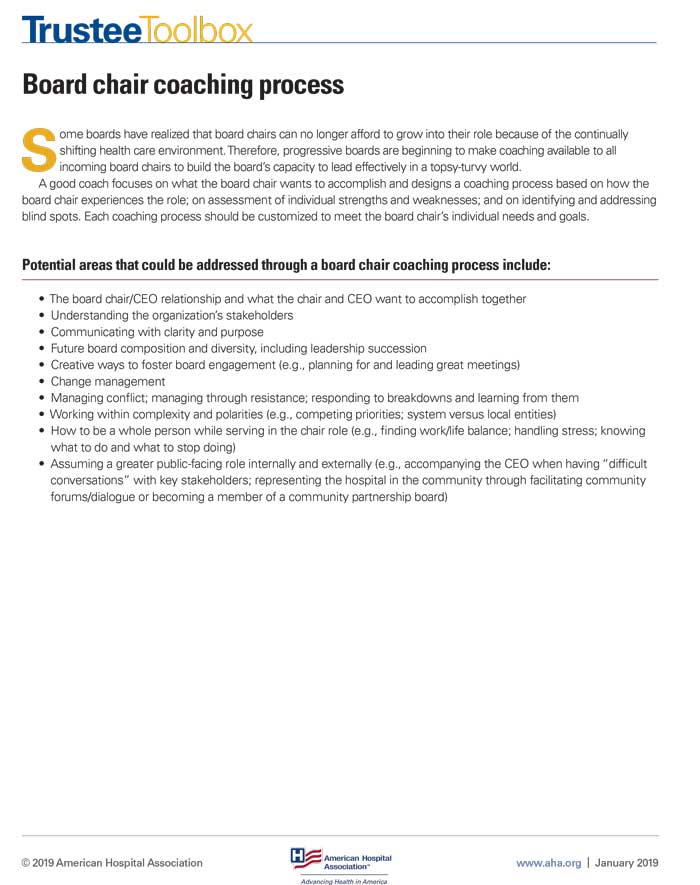
Board Development
Coaching: A Critical Tool for Board Chair Development
A tailored process helps incoming leaders become more effective facilitators of boardroom discussion
By Pamela R. Knecht, Kimberly McNally and Mary Totten
Practical
Governance
Board development often results from a variety of situations. For example, the results of a board self-evaluation may uncover opportunities for development through education and training or creation of deeper infrastructure to improve board function. Individual board member assessment (e.g., 360 process or peer review) can reveal development needs that might be addressed through a personal development plan.
Boards and their members will always benefit from ongoing development activities. However, in today’s dynamic, high-stakes environment for health care governance, the potential for outsized impact from continuous learning has perhaps never been greater, particularly for the leader at the top — the board chair.
Addressing Needs and Challenges
Many situations can trigger opportunities for board chair development. Several tools and approaches often are used together to enhance board chair performance. These can include coaching, which might focus broadly on chair roles and responsibilities or more narrowly on specific situations and needs. Consider the following examples.
Scenario 1: A large health system underwent a governance restructuring, which resulted in a new health system board. Opportunities for board leader development also became apparent. The board chair and committee chairs needed to strengthen meeting facilitation techniques, group decision making and other aspects of meeting preparation and execution, and elevate their perspective to ensure effective system-level governance. The new system board chair had never chaired the board of a large organization and was overwhelmed in his new role. Board chair and board leader coaching was used (along with educating the full board and creating new governance processes and supporting resources) to create context and infrastructure for effective system governance and to support the new system board chair in becoming a great board leader.
Scenario 2: Another health system had recently appointed a new system board chair. The new chair had been an executive of a large consulting firm and previously chaired the board of another system entity. It quickly became clear that the new chair was implementing his role more like a CEO and consultant than a board chair. He offered ideas for solutions to problems, rather than facilitating board input, and spent more time talking than engaging others in discussion. During meetings, board members became visibly frustrated when the new chair wouldn’t let others speak or discouraged further discussion. Due to the board chair’s lack of time management, a few issues might absorb most of the board’s focus, leaving little time to address other agenda items. The system CEO, with agreement from the board chair, asked a consultant engaged to address governance best practices to provide additional help coaching the new board chair to better execute his role. New processes were developed for drafting board meeting agendas and materials and involving the board chair in their review. Coaching concluded with implementation of a custom self-evaluation focused on the board’s role and performance in advancing system integration, including an action plan to sustain governance improvement.
Coaching the Incoming Chair
Some boards have realized that board chairs can no longer afford to grow into their role because of the continually shifting health care environment. Therefore, progressive boards are beginning to make coaching available to all incoming board chairs to build the chair’s capacity to lead the board effectively in a topsy-turvy world.
Preparing a new chair to hit the ground running requires coaching in advance of assuming the role. A good coach can help equip a new chair with the following skills to lead from a position of strength: supporting the board to govern effectively through ongoing stress; leading meetings in the moment, while thinking ahead; being a systems thinker; competently facilitating versus directing board discussion; encouraging constructive tension; being sensitive to the chair’s effect on others; and knowing when to ask for help.
Effective coaching also depends on pairing the new chair with the right coach. Factors in selecting a coach include not only the coach’s qualifications, but also the right chemistry — assessing whether the chair and coach are likely to develop a productive relationship. The board chair should interview more than one coach to determine each coach’s philosophy and discuss previous work the coach has done. Coaching experience in a health care organization and service on a board, while not required, can be a plus.
Some boards ask a prior chair to mentor an incoming board chair. Mentoring and coaching differ. Mentoring pairs a new chair with a seasoned board chair or member who can answer questions, provide socialization and make introductions, and clarify the board’s culture. A coach, in partnership with the board chair, provides a structured, outcomes-driven process for board leadership development.
A good coach focuses on what the board chair wants to accomplish and designs a coaching process based on:
- Understanding how the board chair experiences the role
- Assessing individual strengths and weaknesses, and
- Identifying and addressing blind spots.
Each coaching process should be customized to address individual needs and goals. Fertile areas for coaching and steps that should be included in a board coaching process appear in the "Board Chair Coaching Process" Trustee Toolbox.
Coaching Experience Impact
The Commonwealth Care Alliance (CCA) is a Massachusetts-based health plan for individuals dually eligible for MassHealth (Medicaid) and Medicare. As the new CEO of CCA, Chris Palmieri worked with both his executive coach and a consultant hired to strengthen CCA governance and provide coaching to support the transition between the retiring and incoming board chairs.
“Having both coaches work together was very helpful in framing the board/CEO relationship,” Palmieri said. “My executive coach focused on helping me advance in my role as CEO and strategize about where I needed to assist in evolving the board in order to meet the organization’s objectives. Our governance coach worked with the executive coach to validate where the board needed to go and prepared the board chair and full board to move in that direction.
“The governance coach also provided feedback regarding how I was perceived by the board, so we could strengthen that relationship rapidly,” Palmieri said. “Coaching can help a new CEO and new board chair work effectively together without a lot of trial and error.”
AtlantiCare is an Egg Harbor Township, N.J.-based health system that is now part of Geisinger, a health system serving Pennsylvania and New Jersey. Before becoming board chair of AtlantiCare, Michael Charlton opted to participate in board coaching. He looked to the coaching process to achieve two primary goals: (1) to establish a communication process with AtlantiCare CEO Lori Herndon that would further strengthen their already positive working relationship, and (2) to help take the organization to the next level by becoming an effective facilitator of both strategic and generative conversations among the board.
“Coaching helped me understand that legacy governance is over in health care — and that a board chair’s job is to harness the creativity of the entire board and engage the board and organizational leadership in decision making,” Charlton said. “This was a shift for me because I was used to being the CEO of my company, providing direction, making decisions and being able to turn on a dime when necessary.”
Now in his third of four years as board chair, Charlton elected to continue his coaching relationship throughout his term as chair. He reflected on how the coaching process has changed over time. “After the first year of coaching, which focused on working to achieve my goals, the purpose shifted to about a 30 percent focus on maintaining what I had learned and a 70 percent emphasis on learning about innovative ideas being applied by other boards around the country,” he said.
“My coach and I continue to talk about ways I can react differently in situations where my first instinct is to ‘lean in’ and problem solve,” Charlton said. “I am also thinking about succession for my role and what we can do to help all of our incoming board and committee chairs become better leaders.”
As a longtime participant in executive coaching, Herndon strongly recommends coaching as a tool for building a productive relationship between a CEO and new board chair. “Michael and I were both committed to the coaching process and found it tremendously valuable,” she said. “It provided us with third-party feedback and a safe, comfortable environment to talk about our leadership styles and how we could improve. We developed a closer relationship and understood what each of us expected from the other. This gave me confidence that, when we disagreed about something, we would be able to talk it through.
“If a new leader has never been coached, I would recommend that he or she consider it,” Herndon said. “Don’t wait until there’s a conflict. Coaching is a process that can elevate performance at any point in someone’s career or participation in a leadership role.”

